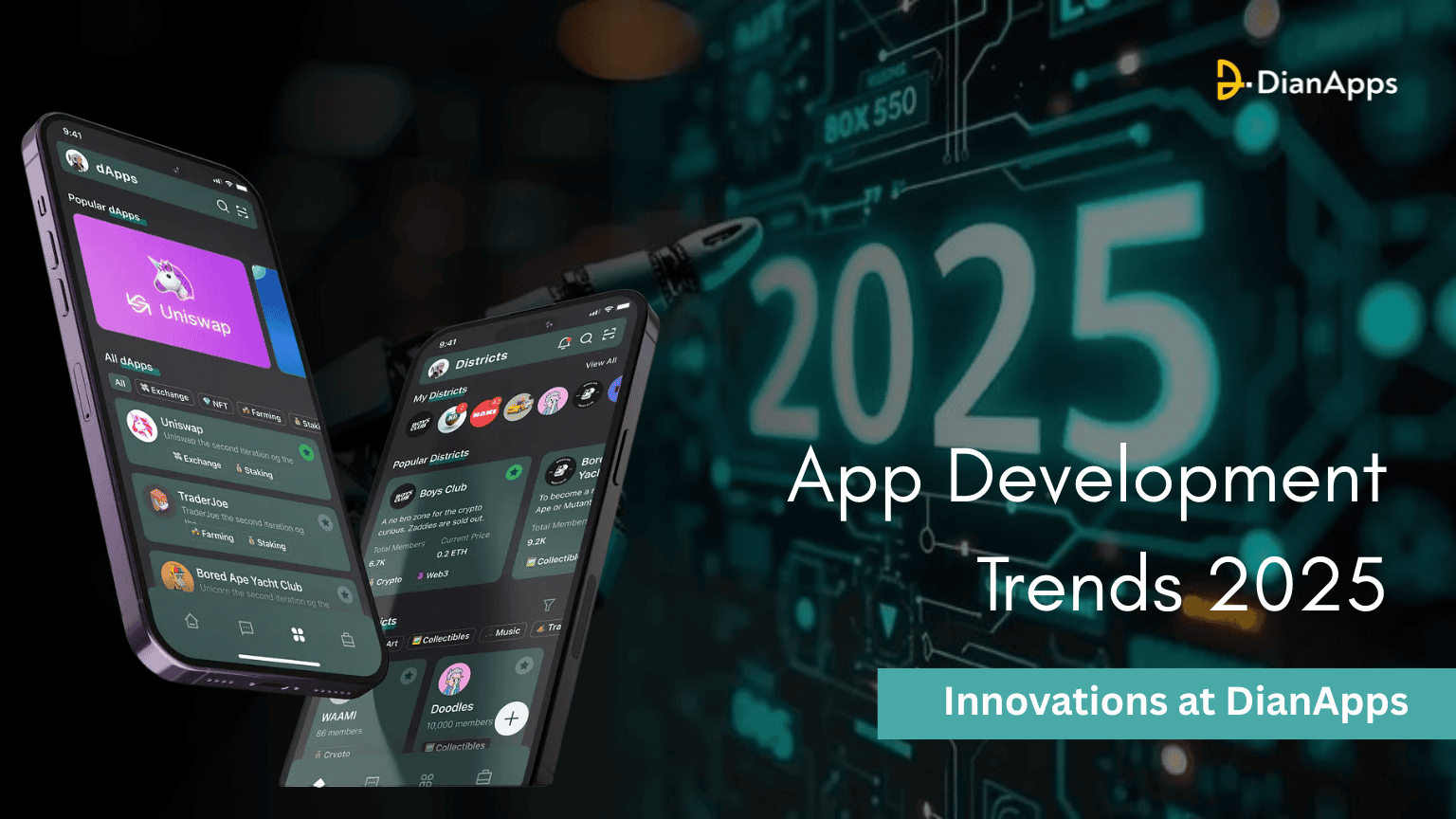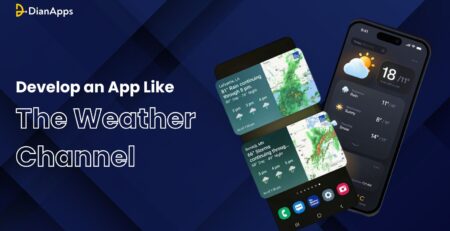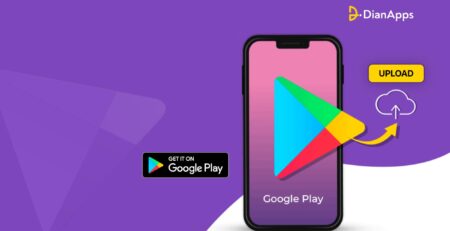App Development Trends 2025: Innovations at DianApps
There are two popular words transforming the world currently: Artificial Intelligence. AI is one of the biggest tech trends, shaping industries, including mobile app development. But AI isn’t the only technology transforming the industry. Several other innovative trends are also shaping the future of app development.
The enhanced use of mobile apps allows businesses to maximize operational efficiency and connect with potential customers. The mobile app market is expected to reach $614.40 billion by 2026. With an expansion of the mobile app market revenue comes the major responsibility of enhancing based on the latest market trends.
According to the Grandview research report, it has been estimated that mobile app users will continuously grow from 2020-2030 at a 14.3% Global Market CAGR.
 (Source)
(Source)
Businesses are continuously spending on digital transformation due to its more efficient nature and to stay competitive in the market. It isn’t just a statement, but a report by IDC shows that by 2027, the global digitalization market will reach $4 trillion. As a result, innovative and more challenging mobile app development trends have emerged globally.
Therefore, if you are looking to grow your business through an app development practice, be sure to connect with a leading mobile app development company. The teams at these firms are experts in the latest app development trends to ensure they deliver the best solutions to your customers.
So, whether you are an entrepreneur, investor, coder, business owner, or product owner, this blog will help you learn about the top mobile application trends.
Innovative Mobile App Development Trends by DianApps
After in-depth research on multiple platforms, here is a curated list of the best mobile app trends for 2025 divided based on the UX app design trends, iOS and Android app development trends, and upcoming mobile app trends.
Double Down on Motion Design
If you are planning to design an app, you surely think about a simple interface that is easily accessible. Most users get impatient with a steady and complex design that
provides no engagement. This is where the need for motion design is realized, to attract user attention. Motion design icons help with engagement, animated scrolling, macro interaction, and interactivity.
For example, a leading UI/UX design service company like DianApps ensures the incorporation of motion design features in their client’s application, such as Thousand Greens, leading to an enhanced user experience.
Smart and Inclusive UX App Design
Until an app provides a personalized experience, a user won’t feel connected, so to build this connection, designers need to incorporate users in the app design. For instance, Pinterest has incorporated an exclusive feature of skin tone ranges that allows users to make beauty-related searches based on a set of skin tones.
 (Source)
(Source)
This feature, introduced by Pinterest, is used by most people and, therefore, is in high demand. Hence, this accessibility and inclusivity feature is considered another best mobile app trend.
Recommended Read: User-Centric Design: The Importance of UX/UI in Mobile App Development
Touchless UI
Non-touch-based interactions have become common among people worldwide, leading to a shift toward touchless user interfaces. Some common examples of touchless interfaces are facial recognition and touchless apps.
Except this, most users have also accessed this feature while signing in or identifying users via biometrics in the apps. This feature is widely used by finance or payment apps. Another latest mobile app trend is UI gesture control, this trend can be regulated by moving your head or screen. From traditional mobile app features to innovative AR/VR experiences, the upcoming few years are going to be more exciting.
Camera-Focused Mobile Apps
Since the remote working setup, most customers have been demanding an app with a camera feature. Users feel connected and engaged with an app that allows them to take videos and pictures that are shareable.
This is the prime reason why Instagram and Facebook have gained so much popularity as social networking apps. According to Statista, Instagram users will continuously be increasing between 2024 and 2028 by in total of 361.1 million users. This trend is much more popular amongst entertainment, broadcasting, and social media niches.
Low Code/No Code
Low Code or No Code is one of the most popular mobile app trends among developers these days. Most development companies leverage low-code tools to build an interactive application in less time.
Low-code and no-code features allow developers and professionals to build an application quickly and more effectively by staying within a visual software development environment. By 2027, the low-code market is expected to reach 65 billion. This trend ensures mobile app development without coding.
Customized Apps for Foldable Devices
The First Foldable device was introduced by Samsung in 2019. Following this innovation, Motorola also introduced its foldable smartphone in the market. This information shows the growing mobile app development trend in 2025 and the upcoming years.

Due to the large screen of foldable devices, mobile app developers have to optimize an app based on foldable devices. However, this innovation could be considered the future of mobile app development. This same process goes with wearable devices where an app can be customized as per the customer’s requirement. The future of wearable technology is growing with multiple opportunities.
Predictive Analytics
You must have surely heard of this mobile app development trend several times. Predictive analytics has the potential to forecast events with the help of data using the latest technologies, such as AI, machine learning, mining, data modeling, etc.
One of the most common predictive analytics examples in video streaming apps is Netflix’s offering, which recommends shows based on the user’s previous searches. This trend is also being used to enhance user experience, and it ensures to provide a unique experience for every individual.
It can also be used to present product suggestions and history based on each user’s search behavior.
On-Demand Apps
On-demand apps have gained major popularity after the COVID-19 breakdown. According to a PwC report, the on-demand economy is expected to reach $335 billion by the year 2025. This report shows that on-demand apps are further considered the future of application development, highlighting that the on-demand app will continue to grow.
Do on-demand apps make a difference for app developers and business owners? Yes, now on-demand app development can be used to offer aries functionalities and features to meet the growing customer needs. Moreover, on-demand applications are more likely to simplify the mobile app development process.
Be sure to leverage the right mobile app development trend, as the right app trend can make your business more visible and accessible among your target audience. Another major reason for the usage of the correct trend is to foster brand awareness and reach potential customers by establishing your authority niche.
One of the best ways to leverage the perfect mobile app development trend is partnering with an experienced iOS app development company in NewYork.
5G Technology
When 4G came into the real world, everyone was fascinated with its high data speed, similarly, 5G has surprised mobile data users with its innovative features. These 5G technology features have transformed mobile app development by offering increased network capacity, data speeds, and lower latency. This growing trend allows developers to make more engaging and complex app experiences.
Features such as fast data speed and low latency provide app developers with new opportunities to make interactive, data-intensive, and creative applications that can reinvent industries and provide an enhanced user experience to customers.
Cloud Computing
Cloud computing is widely used by businesses across the globe. This shows increasing cloud spending in the upcoming years, as, according to IDC forecasts, global cloud infrastructure investments are expected to reach $1.35 trillion by 2027.
Cloud computing innovation has changed mobile app development by providing businesses with a flexible and scalable infrastructure. Businesses can process and store data remotely with the help of cloud services, leading to a reduced burden on device resources. This seamless integration across multiple devices ensures consistent device resources.
Furthermore, cloud computing ensures easy updates and maintenance, with an efficient collaboration among development teams. By utilizing the capabilities of cloud computing, mobile apps can efficiently deliver data-driven, resource-efficient, and innovative solutions.
Mobile App Development Frameworks
There are different types of mobile applications, and for the development of each app category, developers need to leverage distinct frameworks. For this reason, mobile app development frameworks are classified into three categories: Cross-platform, Hybrid, and Native frameworks.
Native Framework
Native frameworks are used for the development of specific operating systems such as iOS and Android. Here are a few Native frameworks that you definitely need to understand:
Android Studio (For Android Apps Only)
Android Studio is considered the best framework for Android app development. It was launched by Google in 2013 as the official Integrated Development Environment (IDE). It uses different programming languages, such as Kotlin and Java.
Xcode (For iOS)
This framework is specifically dedicated to Apple’s IDE to create macOS, watchOS, tvOS, and iOS apps. Xcode was launched in 2003 and utilizes Swift and Objective-C programming languages.
Cross-Platform Frameworks:
The cross-platform framework allows developers to write code once and deploy it across multiple platforms, such as Android and iOS. This framework is used to save time and resources for the business owner.
Flutter
Flutter is a leading cross-platform framework that was first established in 2015 at the Dart Developer Summit. According to Statista, around 46% of software uses the Flutter framework to build an app; this highlights its importance among developers.
React Native
React Native is one of the most popular open-source UI frameworks that was first established in 2015. According to the research report presented by Statista, it has been showcased that it is the second most popular cross-platform framework, which is used by around 35% of seasoned developers.
Recommended Read: How to Create Android MVP App With React Native Framework
Hybrid Frameworks
Hybrid frameworks combine web technologies like HTML, JavaScript, and CSS with native elements, allowing developers to create apps that work across different platforms. Similar to cross-platform applications, hybrid apps allow developers to run an app using a single codebase across multiple platforms. Now, it’s time to look at the mobile app development frameworks:
Ionic
Ionic is an open-source UI toolkit that uses web technologies like HTML, CSS, and JavaScript to create cross-platform mobile and online applications. It uses React, Vue, or Angular and interacts with Cordova or Capacitor for native features, providing a single codebase and speedy development.
Xamarin
Xamarin is a Microsoft-supported framework for creating cross-platform apps with C# and .NET that is currently a component of .NET MAUI. With native performance and user interface, it allows developers to exchange code across iOS, Android, and Windows. It saves time and effort by simplifying UI development using Xamarin.Forms.
Recommended Read: Why Are Businesses Adopting Hybrid App Development in 2025?
Final Words
Finally, mobile app development has come a long way with innovative mobile app trends that can be used to enhance user engagement and conversion rates. If you want to step into this growing technological trend, be sure to connect with a leading digital mobile and website development company known for its step-by-step agile development methodology practices.
DianApps has 100+ development experts who have worked with leading brand names such as KFC, Minimalist, Thousand Greens, and more. Get in touch with our experts to discuss your next app idea and get started.




